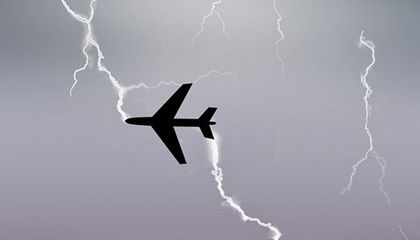Aviation
What Happens When Lightning Strikes an Airplane?

In the world, lightning strikes about 3 billion times a year and kills an average of 6000 people. Lightning strikes on commercial planes are daily occurrences. In, fact, aircraft often trigger lightning when flying through a heavily charged region of a cloud. In these instances, the lightning flash originates at the airplane and extends away in opposite directions.
For safety reasons, planes hit by lightning mid-flight undergo inspection after landing but in most cases, the aircraft is either unharmed or only minor damaged but it costs airline more than $2 billion per year. Prior to the next flight, the aircraft is grounded and thoroughly inspected for damage, affecting its availability.
How does it work ? MCAS Boeing 737 Max System.
The last major accident caused by lightning was in 1967, when lightning cased a catastrophic fuel tank explosion. since then, more techniques have been determined to reduce the threat of lightning.
Although passengers and crew can see a flash and hear a loud noise, if lightning strikes their plane, nothing serious should happen because of the lightning protection in the aircraft. Initially, the lightning will strike to a nose or wing tip. the airplanes then flies through the lightning flash. The current will travel through the conductive exterior skin and structure of the aircraft and exits through the tail.
Boeing 737 Max to be operated most of the world except one country
Most aircraft skins consist primarily of aluminium. which conducts electricity very well. Some modern aircraft like Boeing 787 and the Airbus A350 are made of advanced composite material like carbon fibers, resulting in a reduced electrical conductivity of the fuselage and wings.
Bottom line, lightning strikes are not a severe problem from a safety issue. If the plane diverts its route, it is mainly because of hail, rather than lightning.
EgyptAir plane crash ‘was caused by overheating iPad in cockpit

Aviation
COMAC Unveils Plans for the C929 to Rival Airbus and Boeing

After the success of China’s first C919 aircraft, the country is setting its sights on developing a larger plane. COMAC (Commercial Aircraft Corporation of China) has officially confirmed plans to build a widebody aircraft, marking a significant step in its aircraft lineup.
Traditionally, Airbus and Boeing dominate the widebody aircraft market, with decades of expertise in developing planes and engines capable of carrying heavy payloads. China, which currently relies on imported engines, is now aiming to challenge these giants with its own widebody jet, the C929, designed to compete with the Airbus A350 and Boeing 777.
American Airlines Is Looking for Flight Attendants: Apply Now
The C929 will be China’s first independently developed long-range widebody aircraft. It adheres to international airworthiness standards and boasts independent intellectual property rights. The baseline version is designed to seat 280 passengers and offers a range of 12,000 kilometers, catering to global demand for both regional and international air travel.
Russia, which also needs reliable narrowbody and widebody aircraft, could become a key customer for the C929. Additionally, China plans to target the broader Asian market as it continues to expand its aviation capabilities.
Close Call at Heathrow: BA Flight Narrowly Escapes Drone Collision
China’s aviation progress includes the ARJ21 (now called C909), a regional jet with 100 seats for shorter routes, and the C919, a narrowbody jet with 180 seats designed to rival the Boeing 737 MAX and Airbus A320. Both models have found increasing demand in the domestic market.
At China’s largest air show in Zhuhai, COMAC announced that Air China will be the launch customer for the C929 widebody jet, though details about order size and delivery timelines were not disclosed.
Other major deals announced by COMAC include:
- Hainan Airlines: Firm orders for 60 C919 and 40 C909 regional jets.
- Colorful Guizhou Airlines: 30 C909 jets, with 20 firm orders and 10 provisional agreements.
The C929, renamed from the CR929 after Russia withdrew from the joint development project in 2023, is expected to carry 280–400 passengers with a range of 12,000 kilometers, competing directly with Boeing’s 787 Dreamliner.
According to COMAC’s deputy general manager, Tong Yu, the first fuselage section of the C929 is expected by September 2027, with prototype test flights anticipated soon after.
-

 Aviation2 months ago
Aviation2 months agoMicrosoft Flight Simulator Raises $3 Million to Bring Back the An-225 Mriya
-

 Airlines2 months ago
Airlines2 months agoQantas Engineers Stage Walkout Over Cost of Living Concerns
-

 Airlines2 months ago
Airlines2 months agoQatar Citizens Can Travel to the United States Without a Visa
-

 Aviation2 months ago
Aviation2 months agoQatar Airways bans these new Electronic Devices on plane
-

 Airlines2 months ago
Airlines2 months agoJapan Airlines Rolls Out Free Domestic Flights to International Passengers
-

 Defence2 months ago
Defence2 months agoWhich Country Has the Largest Fleet of Fighter Aircraft?
-

 Airport2 months ago
Airport2 months agoWestern Sydney Airport Welcomes Its First Plane After 6 Years of construction
-

 Travel2 months ago
Travel2 months agoQatar Airways Launches Four Additional Flights from Amsterdam








